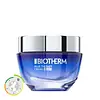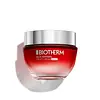What's inside
What's inside
 Key Ingredients
Key Ingredients

 Benefits
Benefits

 Concerns
Concerns

 Ingredients Side-by-side
Ingredients Side-by-side

Water
Skin ConditioningHydrogenated Polyisobutene
EmollientGlycerin
HumectantButylene Glycol
HumectantDimethicone
EmollientCetyl Alcohol
EmollientGlyceryl Stearate
EmollientZea Mays Starch
AbsorbentElaeis Guineensis Oil
EmollientParaffinum Liquidum
EmollientPEG-100 Stearate
Cera Alba
EmollientSorbitol
HumectantMyristyl Myristate
EmollientZea Mays Oil
EmulsifyingPEG-14m
Emulsion StabilisingCera Microcristallina
Emulsion StabilisingParaffin
PerfumingAlgae
Skin ConditioningSorbitan Tristearate
EmulsifyingGlyceryl Acrylate/Acrylic Acid Copolymer
HumectantDimethyl Isosorbide
SolventIsohexadecane
EmollientLaminaria Ochroleuca Extract
Skin ConditioningSodium Hydroxide
BufferingMoringa Oleifera Seed Extract
Skin Conditioning2-Oleamido-1,3-Octadecanediol
Skin ConditioningPhenoxyethanol
PreservativePrunus Armeniaca Kernel Oil
MaskingAdenosine
Skin ConditioningChlorphenesin
AntimicrobialDisodium EDTA
Propylene Glycol
HumectantHydroxypropyl Tetrahydropyrantriol
Skin ConditioningCapryloyl Salicylic Acid
ExfoliatingVitreoscilla Ferment
Skin ConditioningPassiflora Edulis Seed Oil
EmollientXanthan Gum
EmulsifyingMaltitol
HumectantPentaerythrityl Tetra-Di-T-Butyl Hydroxyhydrocinnamate
AntioxidantOctyldodecanol
EmollientAcrylamide/Sodium Acryloyldimethyltaurate Copolymer
Emulsion StabilisingPolysorbate 80
EmulsifyingOryza Sativa Bran Oil
EmollientParfum
MaskingWater, Hydrogenated Polyisobutene, Glycerin, Butylene Glycol, Dimethicone, Cetyl Alcohol, Glyceryl Stearate, Zea Mays Starch, Elaeis Guineensis Oil, Paraffinum Liquidum, PEG-100 Stearate, Cera Alba, Sorbitol, Myristyl Myristate, Zea Mays Oil, PEG-14m, Cera Microcristallina, Paraffin, Algae, Sorbitan Tristearate, Glyceryl Acrylate/Acrylic Acid Copolymer, Dimethyl Isosorbide, Isohexadecane, Laminaria Ochroleuca Extract, Sodium Hydroxide, Moringa Oleifera Seed Extract, 2-Oleamido-1,3-Octadecanediol, Phenoxyethanol, Prunus Armeniaca Kernel Oil, Adenosine, Chlorphenesin, Disodium EDTA, Propylene Glycol, Hydroxypropyl Tetrahydropyrantriol, Capryloyl Salicylic Acid, Vitreoscilla Ferment, Passiflora Edulis Seed Oil, Xanthan Gum, Maltitol, Pentaerythrityl Tetra-Di-T-Butyl Hydroxyhydrocinnamate, Octyldodecanol, Acrylamide/Sodium Acryloyldimethyltaurate Copolymer, Polysorbate 80, Oryza Sativa Bran Oil, Parfum
Water
Skin ConditioningGlycerin
HumectantDicaprylyl Carbonate
EmollientAlcohol Denat.
AntimicrobialSimmondsia Chinensis Seed Oil
EmollientCocos Nucifera Oil
MaskingPersea Gratissima Oil
Skin ConditioningMangifera Indica Seed Butter
Skin ConditioningHydrogenated Coco-Glycerides
EmollientPentylene Glycol
Skin ConditioningCetearyl Alcohol
EmollientArachidyl Alcohol
EmollientCopernicia Cerifera Cera
EmollientGardenia Taitensis Flower
Skin ConditioningPrunus Armeniaca Kernel Oil
MaskingAlaria Esculenta Extract
Skin ProtectingCarrageenan
Tin Oxide
AbrasiveStearic Acid
CleansingCeramide NP
Skin ConditioningSqualane
EmollientCarbomer
Emulsion StabilisingArachidyl Glucoside
EmulsifyingCalcium Chloride
AstringentBehenyl Alcohol
EmollientCeteareth-20
CleansingCetearyl Glucoside
EmulsifyingSodium Hyaluronate
HumectantSodium Hydroxide
BufferingSodium Lactate
BufferingSodium Stearate
CleansingSodium Stearoyl Glutamate
CleansingSilica
AbrasiveMyristic Acid
Cleansing2-Oleamido-1,3-Octadecanediol
Skin ConditioningPalmitic Acid
EmollientPalmitoyl Tetrapeptide-7
Skin ConditioningPalmitoyl Tripeptide-1
Skin ConditioningAdenosine
Skin ConditioningPhenylethyl Resorcinol
AntioxidantAmmonium Acryloyldimethyltaurate/Steareth-25 Methacrylate Crosspolymer
Emulsion StabilisingHydroxypalmitoyl Sphinganine
Skin ConditioningCaprylic/Capric Triglyceride
MaskingCaprylyl Glycol
EmollientVitreoscilla Ferment
Skin ConditioningAcetyl Dipeptide-1 Cetyl Ester
Skin ConditioningSynthetic Fluorphlogopite
Polysorbate 20
EmulsifyingButylene Glycol
HumectantTocopherol
AntioxidantTocopheryl Acetate
AntioxidantPentaerythrityl Tetra-Di-T-Butyl Hydroxyhydrocinnamate
AntioxidantSalicylic Acid
MaskingMica
Cosmetic ColorantCI 77163
Cosmetic ColorantCI 77491
Cosmetic ColorantCI 77891
Cosmetic ColorantParfum
MaskingWater, Glycerin, Dicaprylyl Carbonate, Alcohol Denat., Simmondsia Chinensis Seed Oil, Cocos Nucifera Oil, Persea Gratissima Oil, Mangifera Indica Seed Butter, Hydrogenated Coco-Glycerides, Pentylene Glycol, Cetearyl Alcohol, Arachidyl Alcohol, Copernicia Cerifera Cera, Gardenia Taitensis Flower, Prunus Armeniaca Kernel Oil, Alaria Esculenta Extract, Carrageenan, Tin Oxide, Stearic Acid, Ceramide NP, Squalane, Carbomer, Arachidyl Glucoside, Calcium Chloride, Behenyl Alcohol, Ceteareth-20, Cetearyl Glucoside, Sodium Hyaluronate, Sodium Hydroxide, Sodium Lactate, Sodium Stearate, Sodium Stearoyl Glutamate, Silica, Myristic Acid, 2-Oleamido-1,3-Octadecanediol, Palmitic Acid, Palmitoyl Tetrapeptide-7, Palmitoyl Tripeptide-1, Adenosine, Phenylethyl Resorcinol, Ammonium Acryloyldimethyltaurate/Steareth-25 Methacrylate Crosspolymer, Hydroxypalmitoyl Sphinganine, Caprylic/Capric Triglyceride, Caprylyl Glycol, Vitreoscilla Ferment, Acetyl Dipeptide-1 Cetyl Ester, Synthetic Fluorphlogopite, Polysorbate 20, Butylene Glycol, Tocopherol, Tocopheryl Acetate, Pentaerythrityl Tetra-Di-T-Butyl Hydroxyhydrocinnamate, Salicylic Acid, Mica, CI 77163, CI 77491, CI 77891, Parfum
Ingredients Explained
These ingredients are found in both products.
Ingredients higher up in an ingredient list are typically present in a larger amount.
We don't have a description for 2-Oleamido-1,3-Octadecanediol yet.
Adenosine is in every living organism. It is one of four components in nucleic acids that helps store our DNA.
Adenosine has many benefits when used. These benefits include hydrating the skin, smoothing skin, and reducing wrinkles. Once applied, adenosine increases collagen production. It also helps with improving firmness and tissue repair.
Studies have found adenosine may also help with wound healing.
In skincare products, Adenosine is usually derived from yeast.
Learn more about AdenosineButylene Glycol (or BG) is used within cosmetic products for a few different reasons:
Overall, Butylene Glycol is a safe and well-rounded ingredient that works well with other ingredients.
Though this ingredient works well with most skin types, some people with sensitive skin may experience a reaction such as allergic rashes, closed comedones, or itchiness.
Learn more about Butylene GlycolGlycerin is already naturally found in your skin. It helps moisturize and protect your skin.
A study from 2016 found glycerin to be more effective as a humectant than AHAs and hyaluronic acid.
As a humectant, it helps the skin stay hydrated by pulling moisture to your skin. The low molecular weight of glycerin allows it to pull moisture into the deeper layers of your skin.
Hydrated skin improves your skin barrier; Your skin barrier helps protect against irritants and bacteria.
Glycerin has also been found to have antimicrobial and antiviral properties. Due to these properties, glycerin is often used in wound and burn treatments.
In cosmetics, glycerin is usually derived from plants such as soybean or palm. However, it can also be sourced from animals, such as tallow or animal fat.
This ingredient is organic, colorless, odorless, and non-toxic.
Glycerin is the name for this ingredient in American English. British English uses Glycerol/Glycerine.
Learn more about GlycerinParfum is a catch-all term for an ingredient or more that is used to give a scent to products.
Also called "fragrance", this ingredient can be a blend of hundreds of chemicals or plant oils. This means every product with "fragrance" or "parfum" in the ingredients list is a different mixture.
For instance, Habanolide is a proprietary trade name for a specific aroma chemical. When used as a fragrance ingredient in cosmetics, most aroma chemicals fall under the broad labeling category of “FRAGRANCE” or “PARFUM” according to EU and US regulations.
The term 'parfum' or 'fragrance' is not regulated in many countries. In many cases, it is up to the brand to define this term.
For instance, many brands choose to label themselves as "fragrance-free" because they are not using synthetic fragrances. However, their products may still contain ingredients such as essential oils that are considered a fragrance by INCI standards.
One example is Calendula flower extract. Calendula is an essential oil that still imparts a scent or 'fragrance'.
Depending on the blend, the ingredients in the mixture can cause allergies and sensitivities on the skin. Some ingredients that are known EU allergens include linalool and citronellol.
Parfum can also be used to mask or cover an unpleasant scent.
The bottom line is: not all fragrances/parfum/ingredients are created equally. If you are worried about fragrances, we recommend taking a closer look at an ingredient. And of course, we always recommend speaking with a professional.
Learn more about ParfumPentaerythrityl Tetra-Di-T-Butyl Hydroxyhydrocinnamate (long name, huh?) is a synthetic antioxidant.
It is used to help stabilize other antioxidants or prevent the color from changing in a product.
As an antioxidant, it helps fight free-radical molecules. Free-radical molecules are capable of damaging our cells and other genetic material. Thus, antioxidants may reduce the signs of aging.
This ingredient is oil-soluble.
Learn more about Pentaerythrityl Tetra-Di-T-Butyl HydroxyhydrocinnamateThis ingredient is the oil from the apricot.
Apricot Kernel Oil is an emollient and helps soften skin. This is due to its fatty acid components. Some of these fatty acids include linoleic and oleic acid.
This ingredient also has antioxidant properties from Vitamins A, C, and E. Antioxidants help fight free-radicals. Free-radicals are molecules that may damage your skin cells. Besides being antioxidants, these vitamins provide plenty of skin benefits as well.
Learn more about Prunus Armeniaca Kernel OilSodium Hydroxide is also known as lye or caustic soda. It is used to adjust the pH of products; many ingredients require a specific pH to be effective.
In small amounts, sodium hydroxide is considered safe to use. However, large amounts may cause chemical burns due to its high alkaline.
Your skin has a natural pH and acid mantle. This acid mantle helps prevent harmful bacteria from breaking through. The acid mantle also helps keep your skin hydrated.
"Alkaline" refers to a high pH level. A low pH level would be considered acidic.
Learn more about Sodium HydroxideVitreoscilla Ferment is a probiotic derived from the Vitreoscilla bacteria.
Studies show Vitreoscilla Ferment to have the same benefits as ingesting probiotics. Probiotics help keep the bacteria in your body healthy.
In general, maintaining a healthy microbiome on your skin has many benefits. One benefit is protection against external and bad bacteria. A healthy microbiome also helps maintain skin hydration and reduce inflammation.
Probiotics work best when combined with prebiotics.
Learn more about Vitreoscilla FermentWater. It's the most common cosmetic ingredient of all. You'll usually see it at the top of ingredient lists, meaning that it makes up the largest part of the product.
So why is it so popular? Water most often acts as a solvent - this means that it helps dissolve other ingredients into the formulation.
You'll also recognize water as that liquid we all need to stay alive. If you see this, drink a glass of water. Stay hydrated!
Learn more about Water